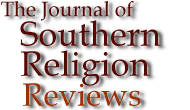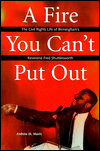



Andrew M. Manis. A Fire You Can’t Put Out: The Civil Rights Life of Birmingham’s Reverend Fred Shuttlesworth. Tuscaloosa: University of Alabama Press, 1999. 445pp + notes and index
![]()
![]()
![]()
During the first two weeks of May 1963, the nation held its collective breath
while watching events unfold in Birmingham, Alabama. Massive demonstrations and boycotts
of downtown merchants during the Easter holiday season were followed by the
“children marches” in May. Birmingham’s intransigent commissioner of
public safety, Eugene “Bull” Connor, unleashed police dogs and fire hoses on
the young demonstrators. With television cameras rolling and nightly news feeds
coming out of the Magic City, Birmingham became the epicenter of the struggle
for civil rights. Andrew Manis’s biography of the Reverend Fred Shuttlesworth
serves as a window on this epic clash over desegregation in Birmingham. For those
familiar with the local struggles over civil rights Shuttlesworth’s place in
history is
known, but for most this book will serve as an introduction to this
under-recognized civil rights leader and
the battle over Birmingham.
| ". . . Shuttlesworth, though largely a local figure, deserves the same recognition as King in the historical understanding of the Civil Rights Movement. " | |
Manis weaves personal interviews with newspaper accounts and editorials, as well as police intelligence reports, to reveal a complex individual living in an explosive era. Starting with his working-class childhood, Manis details Shuttlesworth’s education and ministerial calling to his penchant for activism in Birmingham during the 1950s and 1960s. The body of the work is set off by an introduction and epilogue that explain Shuttleworth’s place in the pantheon of preaching civil rights leaders. “The typical sermons and civil rights addresses of (Martin Luther) King, Shuttlesworth, Ralph David Abernathy, and others to a great degree,” Manis states, “melded into one genre. In a similar vein, these preachers understood their activism as part of their responsibilities as Christian ministers in the African American community.”(2) Manis shows that their activism was a product of their religious convictions, and for none was this more so than Shuttlesworth. He illustrates that Shuttlesworth, though largely a local figure, deserves the same recognition as King in the historical understanding of the Civil Rights Movement. Shuttlesworth, unlike King, explained civil rights in the language of African-American faith, not theological concepts associated with the Social Gospel. In a phrase, “civil rights preacher,” Manis captures Shuttlesworth’s place on the religious/political continuum of African-American faith: radical activist and conservative preacher.
Manis has the uncanny ability to describe the events surrounding Birmingham in the 1950s and 1960s while focusing the interpretative lens on much of what happened during the Civil Rights Movement. He shows a fragmented black community but also reveals how they pulled together (“conflict in unity”) to fight a common foe: segregation. (187) Manis encourages historians to look beyond the national movement and recognize the local fight for freedom. After all, there would be no movement without individuals committing their lives to the cause. Martin Luther King’s dominance in the national spotlight made it easy for other figures, including Shuttlesworth, to be unfairly displaced. The movement had many layers, and Manis’s work encourages us to look closer at what drove the different factions.
Manis does an impressive job of examining his subject, while exposing more about the movement than intended. He is careful to show Shuttlesworth’s temperamental side and does not explain away criticism as unjust or unwarranted. (In fact, he reveals so much texture about the life of this “fiery preacher” that some readers may become unsympathetic to Shuttlesworth.) Manis argues that Shuttlesworth’s presence in Birmingham and his organizational skill with the Alabama Christian Movement for Human Rights prior to the Southern Christian Leadership Conference’s arrival in the spring of 1963 laid the groundwork for the success of the campaign. Yet ironically Manis is at his best when he focuses less on Shuttlesworth's personality and devotes attention to the dynamics of Birmingham’s black and white communities’ struggle over desegregation. The chapter titled “‘Bull’ fighting” highlights this observation.
It is the biographic genre that keeps the focus on the individual, and perhaps its unintended “cult of personality,” rather than on other factors that led to Birmingham’s place in the national spotlight. For instance, Manis notes that Shuttleworth’s activities “antagonized” segregationists in the city to bring Connor back from political disaster (81) and then keep him there when “moderate” whites grew weary of their public safety commissioner. (161) The argument can be made, as Shuttleworth and others do, that moderate whites moved only after black protests forced them to do so. However, an equally compelling argument could be made, using Manis’s evidence, that Shuttleworth’s “fiery” personality caused Connor’s presence to last longer than it should have.
The focus in African-American faith and civil rights research needs to move to the local level. The dynamics in each southern city make for different scenarios that combined to create the movement. Shuttlesworth’s story can now be added to the collective historiography of both the Civil Rights Movement and African-American religious life. The questions Manis raises and his portrayal of the context in which the Civil Rights Movement occurred make this book a valuable addition to the field.
Douglas E. Thompson, University of Virginia
© 1998-99 by The Journal of Southern Religion. All rights
reserved. ISSN 1094-5234